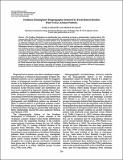Por favor, use este identificador para citar o enlazar a este item:
http://hdl.handle.net/10261/166904COMPARTIR / EXPORTAR:
 SHARE
BASE SHARE
BASE
|
|
| Visualizar otros formatos: MARC | Dublin Core | RDF | ORE | MODS | METS | DIDL | DATACITE | |

| Título: | Southern Hemisphere Biogeography Inferred by Event-Based Models: Plant versus Animal Patterns |
Autor: | Sanmartín, Isabel CSIC ORCID ; Ronquist, Fredrik | Fecha de publicación: | 2004 | Editor: | Society of Systematic Biologists | Citación: | Systematic Biologist 53 (2) : p. 216-243 (2004) | Resumen: | The Southern Hemisphere has traditionally been considered as having a fundamentally vicariant history. The common trans-Pacific disjunctions are usually explained by the sequential breakup of the supercontinent Gondwana during the last 165 million years, causing successive division of an ancestral biota. However, recent biogeographic studies, based on molecular estimates and more accurate paleogeographic reconstructions, indicate that dispersal may have been more important than traditionally assumed.We examined the relative roles played by vicariance and dispersal in shaping Southern Hemisphere biotas by analyzing a large data set of 54 animal and 19 plant phylogenies, including marsupials, ratites, and southern beeches (1,393 terminals). Parsimony-based tree fitting in conjunction with permutation tests was used to examine to what extent Southern Hemisphere biogeographic patterns fit the breakup sequence of Gondwana and to identify concordant dispersal patterns. Consistent with other studies, the animal data are congruent with the geological sequence of Gondwana breakup: (Africa(New Zealand(southern South America, Australia))). Trans-Antarctic dispersal (Australia ↔ southern South America) is also significantly more frequent than any other dispersal event in animals, which may be explained by the long period of geological contact between Australia and South America via Antarctica. In contrast, the dominant pattern in plants, (southern South America(Australia,NewZealand)), is better explained by dispersal, particularly the prevalence of trans-Tasman dispersal between New Zealand and Australia. Our results also confirm the hybrid origin of the South American biota: there has been surprisingly little biotic exchange between the northern tropical and the southern temperate regions of South America, especially for animals. [Concordant dispersal; Gondwana; historical biogeography; parsimony-based tree fitting; Southern Hemisphere; vicariant history; West Wind Drift.] | URI: | http://hdl.handle.net/10261/166904 | ISSN: | 1063-5157 | E-ISSN: | 1076-836X |
| Aparece en las colecciones: | (RJB) Artículos |
Ficheros en este ítem:
| Fichero | Descripción | Tamaño | Formato | |
|---|---|---|---|---|
| Southern Hemisphere Biogeography Inferred.pdf | 3,26 MB | Adobe PDF |  Visualizar/Abrir |
CORE Recommender
Page view(s)
244
checked on 23-abr-2024
Download(s)
956
checked on 23-abr-2024
Google ScholarTM
Check
NOTA: Los ítems de Digital.CSIC están protegidos por copyright, con todos los derechos reservados, a menos que se indique lo contrario.
